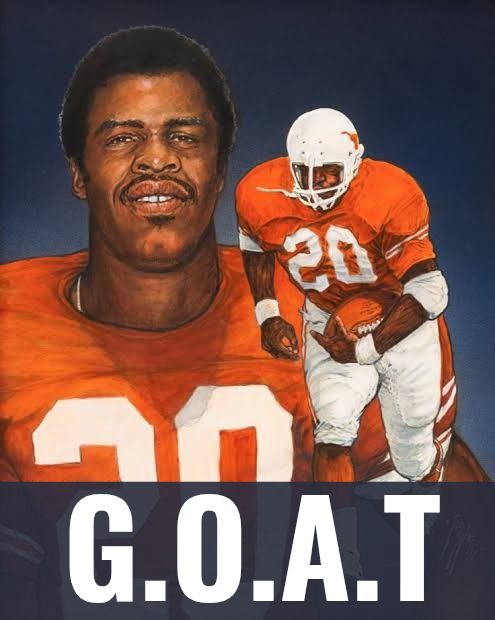
Earl Campbell: The Greatest of All Time in College Football
In a sport rich with history, talent, and incredible feats, the debate over who deserves the title of the Greatest of All Time (GOAT) in college football has always sparked passionate discussion. Every era has produced legendary players who left an indelible mark on the game, shaping not only their programs but also the sport itself. From the hard-hitting power backs to the elusive quarterbacks and the electrifying wide receivers, college football has seen them all. Yet, in a momentous announcement by ESPN, Texas Longhorns legend Earl Campbell has been crowned the Greatest of All Time, besting an illustrious group of competitors, including Georgia’s Herschel Walker, Florida Gators’ Tim Tebow, and Ohio State’s Archie Griffin.
This recognition is a testament not only to Campbell’s dominance on the field but also to the impact he had on the game, his team, and the culture surrounding college football. In the next 2,000 words, we will delve into why Earl Campbell’s name now sits at the very top of the college football mountain, examining his career, his competition, and the lasting legacy he created during his time at the University of Texas.
Earl Campbell’s journey to becoming the Greatest of All Time in college football began long before he stepped onto the field in Austin, Texas. Born on March 29, 1955, in Tyler, Texas, Campbell grew up in a humble household where his love for football was cultivated early. His natural athleticism and work ethic set him apart as a young athlete, but it was his ability to combine raw power with surprising speed that made him stand out even more as a football player. By the time Campbell entered John Tyler High School, he was already a force to be reckoned with.
However, it was his college career that truly made Campbell a legend. After a standout high school career, Campbell received offers from several colleges but chose to play for the Texas Longhorns, a decision that would change the course of college football history.
Campbell’s time at the University of Texas was a period of immense personal and team success. His raw, explosive power as a running back, combined with his ability to outrun defenders, quickly made him one of the most feared players in the country. He became known for his powerful, bruising running style that seemed to wear down opponents over the course of a game. The ability to run over defenders while still having the speed to break away was a unique and rare combination that made him an immediate standout.
In his three years at Texas (1974-1977), Campbell’s impact on the field was undeniable. He rushed for over 1,000 yards in each of his three seasons and established himself as the most dominant running back in college football during that time. His most remarkable achievement came in 1977 when he won the prestigious Heisman Trophy, awarded annually to the best player in college football. Campbell’s Heisman season was one for the ages: he rushed for 1,744 yards, scored 19 touchdowns, and led the Longhorns to a major bowl game appearance.
The legacy of Earl Campbell in college football is impossible to ignore. His unique combination of strength, speed, and vision made him a game-changer, and his performances on the field solidified his place in the annals of college football greatness. But what is it about Campbell that elevates him above other legendary players like Herschel Walker, Tim Tebow, and Archie Griffin?
To fully appreciate Campbell’s standing as the Greatest of All Time in college football, it is essential to examine the remarkable careers of the other candidates in the debate: Herschel Walker, Tim Tebow, and Archie Griffin. Each of these players has an extraordinary legacy in their own right, making the competition for the GOAT title fierce.
Herschel Walker is often considered one of the most physically gifted athletes to ever play college football. Walker’s time at the University of Georgia (1980-1982) was marked by overwhelming success, earning him recognition as one of the best running backs of all time. Walker’s 1982 season, in particular, stands out: he rushed for 1,752 yards and 16 touchdowns, leading Georgia to a national championship. Walker’s combination of size, speed, and strength was unmatched, and his dominance on the field earned him the 1982 Heisman Trophy.
However, despite his undeniable greatness, Walker’s college career did not quite match the sustained dominance that Campbell exhibited. While he had incredible seasons and left a lasting impact on Georgia’s program, Walker’s career at Georgia was not as consistently spectacular as Campbell’s at Texas. In addition, Walker’s decision to play for the New Jersey Generals of the USFL before entering the NFL is a topic of debate among college football historians. Many argue that Campbell’s decision to focus solely on college football allowed him to achieve more, while Walker’s brief professional detour may have diluted his overall legacy in the college ranks.
Tim Tebow is one of the most beloved and polarizing figures in college football history. As the quarterback for the Florida Gators from 2006 to 2009, Tebow led the Gators to two national championships and became the first sophomore in history to win the Heisman Trophy in 2007. Tebow was known for his ability to perform in clutch moments, particularly in big games, and he redefined the dual-threat quarterback position with his unique combination of size, strength, and leadership.
Tebow’s legacy is marked by his ability to take his team to the highest levels of success, and his leadership on and off the field made him a symbol of what college football is all about. However, when comparing his accomplishments to Campbell’s, Tebow’s legacy is more centered around his position as a quarterback, which is quite different from Campbell’s role as a running back. Tebow was incredible, but Campbell’s dominance as a running back was something that could not be replicated. His sheer physical presence on the field made him a game-changer, and his performances in college football are often viewed through the lens of the running back position, which is historically seen as more physically demanding and challenging to dominate in.
Archie Griffin’s college career at Ohio State is legendary in its own right. The only player in college football history to win the Heisman Trophy twice (1974 and 1975), Griffin set a standard of excellence that remains unmatched. His incredible consistency, vision, and ability to break tackles made him a standout during his time at Ohio State, and his achievements still echo throughout the college football world.
However, despite Griffin’s impressive resume, many consider his lack of a national championship and limited success on the national stage to be a black mark on his otherwise stellar career. While Griffin is undoubtedly one of the greatest to ever play the game, his legacy is sometimes overshadowed by the greater team success that players like Campbell and Walker experienced during their college careers.
Now that we have examined the competition, let’s turn our attention back to Earl Campbell and why he rightfully deserves the title of Greatest of All Time in college football.
What sets Earl Campbell apart from other college football legends is the sheer dominance he displayed on the field. Throughout his college career, Campbell averaged more than 6 yards per carry and finished his career with 4,444 rushing yards and 41 touchdowns. These statistics, combined with his raw physicality and ability to wear down defenders, made him nearly unstoppable.
In a time when the running back position was central to a team’s success, Campbell personified everything that was great about it. His powerful, north-south running style made him a nightmare for defenders, and his ability to break tackles and churn out yardage was unmatched. He didn’t just run through arm tackles; he steamrolled over defenders, making them question their decision to even try and stop him.
While Campbell’s numbers are impressive, it is his legacy beyond the statistics that truly sets him apart. His presence on the field was transformative for the Texas Longhorns, and his impact on the culture of college football cannot be overstated. During his time at Texas, Campbell led the Longhorns to a 29-5 record, with two Southwest Conference titles, and he became a symbol of the school’s football program.
Campbell’s Heisman-winning season in 1977 is often viewed as one of the most dominant in college football history. His 1,744 rushing yards and 19 touchdowns helped propel Texas to national prominence, and his performances in big games helped elevate the program to new heights. Even more impressive was his ability to carry the team week in and week out, a true hallmark of greatness.
Beyond the gridiron, Earl Campbell’s influence on the game cannot be understated. His hard-nosed, physical style of running football helped shape the way the game was played in the late 1970s and early 1980s. In a college football landscape that was beginning to see the rise of more pass-heavy offenses, Campbell’s success as a power back reminded fans and analysts alike of the importance of a strong, dominant running game. He represented a return to the foundation of the sport—grit, toughness, and hard work.
Earl Campbell’s status as the Greatest of All Time in college football is well deserved. His extraordinary talent, unmatched physicality, and consistent excellence throughout his college career helped him cement his place in history as a true legend. While players like Herschel Walker, Tim Tebow, and Archie Griffin have their own remarkable legacies, Campbell’s dominance on the field, his transformative impact on college football, and his lasting legacy as the standard for greatness in the sport place him firmly at the top of the college football pantheon.
Earl Campbell’s name will forever be synonymous with greatness, and his Heisman-winning season remains a benchmark for future generations of college football players to strive for. As the Greatest of All Time, Earl Campbell’s legacy will continue to inspire players, coaches, and fans for years to come.





